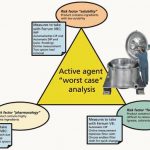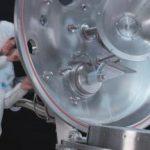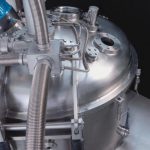Innovation in the engineering industry today is based to a large extent on modularisation of functional units. A modular design in combination with the latest control concept enables users in pharmaceuticals production to adapt machines precisely to suit their individual requirements and thereby strike a balance between functionality and costs. The VBC series of vertical bottom centrifuges effectively illustrates how this can work in real applications.
Sandro Schneider
Pharmaceutical companies in the business of manufacturing drugs are required to clean rooms, devices such as centrifuges as well as other equipment used in the process in accordance with written procedures (“good manufacturing practice“ or GMP). Cleaning validation must be conducted by the companies themselves to select the most suitable method based on regulatory requirements, in-house expertise and generally accepted engineering standards. An innovation from Ferrum in the field of vertical scraper centrifuges considerably simplifies this process.
Not without a risk assessment
The emotive term “cleaning validation” presents a real challenge to pharmaceutical producers as well as to system and equipment suppliers. Mere fulfilment of regulatory requirements is not the only issue. The primary goal is drug safety, but feasibility and efficiency considerations are also relevant. Cleaning validation starts with the validation plan, which is divided into three phases. In all three phases, the system or equipment supplier can make an important contribution to increased feasibility efficiency economy. The aim of the first phase – a status assessment of the planned production line – is to determine which active and inactive ingredients will be produced or used. The frequency at which product changeover will take place has a significant impact on efficiency. It is naturally also important to understand which cleaning agents and methods can or will be employed. The latest VBC centrifuges can already play a part at this stage. The expertise of the equipment supplier is focused on equipment engineering. The supplier delivers a design and a solid/liquid separation process flow. The active agent technology, on the other hand, is not the responsibility of the machine supplier.
The status assessment of the pharmaceutical operation must be followed in the second phase by a risk assessment of all prod-ucts and equipment. Substances that present a special hazard need to be identified, and this is obviously the responsibility of the pharmaceutical maker. However, the centrifuge manufacturer can contribute many years of experience to the assessment of design-related cross-contamination (e.g. surfaces that adsorb substances or are difficult to access, pockets in pipelines and tapping points).
Validation prior to commissioning
Following an operational status assessment and joint risk assessment by the machine supplier and pharmaceutical maker, the scope of validation measures can (must) be defined. During this phase, Ferrum can validate critical design-related areas in its own assembly shops directly after assembly to shorten the list of items that have to be validated at the pharmaceutical site. A riboflavin test, for example, is performed to demonstrate the effectiveness and wettability inside the centrifuge or to check the efficiency of CIP cleaning of inert material in critical areas.
It is therefore in the interests of the pharmaceutical company to complete validation quickly and, if possible, in the phase prior to commissioning. This is only achievable in cases where existing facilities are duplicated. As maximum flexibility in the manufacture of pharmaceuticals is of the essence today, apparatus such as centrifuges must be appropriately flexible in design. Precisely this step was taken at Ferrum with the latest VBC vertical bottom centrifuge. The processes of rinsing, washing, spraying, measuring, analysing, scraping, blowing out, suction and even flooding have been greatly improved in the new generation of centrifuges compared with the state of the art only a few years ago. The special advantage of these centrifuge technology solutions is that many of the different function modules can be integrated flexibly, both in the initial machine configuration and when retrofitted. The cleaning process can be optimally adapted to the respective production sequence.
Cleaning procedure – validation and selection
In order to locate fouling on machine parts, specific samples are taken before and after the cleaning procedure. In the PIC document PI 006, sampling procedures using the wipe or swab test and the flush or rinse test are considered suitable. One advantage of the swab test is that it provides information on the whereabouts of the fouling, e. g. in sharp bends or branches of pipe systems.
It is useful to include global analytical methods, however. Examples of these are TOC determination for organic loading, conductivity measurements for ionic residues and pH measurements for cleaning agent residue detection. These analytical methods can even be incorporated as online measurements on or in the centrifuge. Such methods can be used for multifunction systems to provide maximum flexibility during commissioning, as all possible active and inactive ingredients are often not known. A retrofitting option is offered; this is possible in the majority of cases without redelivery to the manufacturer’s workshop due to the modular design of the VBC.
Passive contribution towards cleanliness in scraper centrifuges
It may sound simple, but good access to the centrifuge is a precondition of its cleaning and analysis, even though fully automatic CIP systems are usually installed. The modular design of the VBC vertical bottom centrifuge takes this into account. The design of the cover opening, the position of the outlet and the basket drive can be selected from a wide range of variants and combinations. This enables the machine to be optimally adapted to the local space conditions at the site of installation without additional expenditure. This is something greatly appreciated by structural engineers and plant constructors as well as by those responsible for maintenance.
Until now, only horizontal centrifuges were considered suitable for installation in a clean room. With the introduction of the VBC, a vertical scraper centrifuge now also meets all requirements for integration in a clean room concept, as the complete drive can be arranged below the vibrating plate. This allows the laboratory area to be separated from the clean room area by means of a diaphragm in the floor or ceiling. This method of installation complies with the wishes of many pharmaceutical companies, because the entire production flow is gravimetric vertical. The vertical bottom centrifuge thus frequently requires less space than a conventional horizontal centrifuge, as this additional clean room area is needed for opening the horizontal housing and positioning the pipes with respect to the vertical product flow into the horizontal machine.
Another important aspect of the VBC’s design is the one-piece concept of the housing and base plate, avoiding numerous edges and transitions with the advantage of less fouling.
The active contribution
The function modules that contribute towards active cleanliness include CIP nozzles. The following principle applies: as many as necessary but as few as possible. Especially in the case of multifunction systems, however, the use of a few additional CIP nozzles may be desirable. In the modular concept of the VBC centrifuge, this does not present a problem because the CIP nozzles are flanged and easily retrofitted (during production) without welding. It goes without saying that these flanges are all provided with GMP-compliant seals.
Those responsible for production in pharmaceutical companies face a far greater problem if the cleaning process must be subsequently changed from CIP cleaning to flood cleaning owing to a change of product. This is another challenge that can easily be solved with the design concept of the VBC, as the complete bearing and sealing system are modular. The bearing cartridge can be pre-fitted as a floodable version and later exchanged for the fitted cartridge (during production) – without having to remove the centrifuge and return it to the manufacturer. After the conversion, the complete centrifuge can be flooded up to the cover if necessary. Another important innovative measure was achieved by the optional use of pneumatic drives for operating the scraper unit and the cover, whereby this movement is effected by precise, self-locking spindle drives. All hydraulic oil is thus banned from the pharmaceuticals area and a further risk factor eliminated.
cpp 405
EG_GMP Guidelines
TechnoPharm 2005
Guide to inspection validation of cleaning processes
Share:









